Yuchen Ren
Improving Adversarial Transferability on Vision Transformers via Forward Propagation Refinement
Mar 19, 2025Abstract:Vision Transformers (ViTs) have been widely applied in various computer vision and vision-language tasks. To gain insights into their robustness in practical scenarios, transferable adversarial examples on ViTs have been extensively studied. A typical approach to improving adversarial transferability is by refining the surrogate model. However, existing work on ViTs has restricted their surrogate refinement to backward propagation. In this work, we instead focus on Forward Propagation Refinement (FPR) and specifically refine two key modules of ViTs: attention maps and token embeddings. For attention maps, we propose Attention Map Diversification (AMD), which diversifies certain attention maps and also implicitly imposes beneficial gradient vanishing during backward propagation. For token embeddings, we propose Momentum Token Embedding (MTE), which accumulates historical token embeddings to stabilize the forward updates in both the Attention and MLP blocks. We conduct extensive experiments with adversarial examples transferred from ViTs to various CNNs and ViTs, demonstrating that our FPR outperforms the current best (backward) surrogate refinement by up to 7.0\% on average. We also validate its superiority against popular defenses and its compatibility with other transfer methods. Codes and appendix are available at https://github.com/RYC-98/FPR.
Biology Instructions: A Dataset and Benchmark for Multi-Omics Sequence Understanding Capability of Large Language Models
Dec 26, 2024Abstract:Large language models have already demonstrated their formidable capabilities in general domains, ushering in a revolutionary transformation. However, exploring and exploiting the extensive knowledge of these models to comprehend multi-omics biology remains underexplored. To fill this research gap, we first introduce Biology-Instructions, the first large-scale multi-omics biological sequences-related instruction-tuning dataset including DNA, RNA, proteins, and multi-molecules, designed to bridge the gap between large language models (LLMs) and complex biological sequences-related tasks. This dataset can enhance the versatility of LLMs by integrating diverse biological sequenced-based prediction tasks with advanced reasoning capabilities, while maintaining conversational fluency. Additionally, we reveal significant performance limitations in even state-of-the-art LLMs on biological sequence-related multi-omics tasks without specialized pre-training and instruction-tuning. We further develop a strong baseline called ChatMultiOmics with a novel three-stage training pipeline, demonstrating the powerful ability to understand biology by using Biology-Instructions. Biology-Instructions and ChatMultiOmics are publicly available and crucial resources for enabling more effective integration of LLMs with multi-omics sequence analysis.
Improving Integrated Gradient-based Transferable Adversarial Examples by Refining the Integration Path
Dec 25, 2024Abstract:Transferable adversarial examples are known to cause threats in practical, black-box attack scenarios. A notable approach to improving transferability is using integrated gradients (IG), originally developed for model interpretability. In this paper, we find that existing IG-based attacks have limited transferability due to their naive adoption of IG in model interpretability. To address this limitation, we focus on the IG integration path and refine it in three aspects: multiplicity, monotonicity, and diversity, supported by theoretical analyses. We propose the Multiple Monotonic Diversified Integrated Gradients (MuMoDIG) attack, which can generate highly transferable adversarial examples on different CNN and ViT models and defenses. Experiments validate that MuMoDIG outperforms the latest IG-based attack by up to 37.3\% and other state-of-the-art attacks by 8.4\%. In general, our study reveals that migrating established techniques to improve transferability may require non-trivial efforts. Code is available at \url{https://github.com/RYC-98/MuMoDIG}.
Model Decides How to Tokenize: Adaptive DNA Sequence Tokenization with MxDNA
Dec 18, 2024Abstract:Foundation models have made significant strides in understanding the genomic language of DNA sequences. However, previous models typically adopt the tokenization methods designed for natural language, which are unsuitable for DNA sequences due to their unique characteristics. In addition, the optimal approach to tokenize DNA remains largely under-explored, and may not be intuitively understood by humans even if discovered. To address these challenges, we introduce MxDNA, a novel framework where the model autonomously learns an effective DNA tokenization strategy through gradient decent. MxDNA employs a sparse Mixture of Convolution Experts coupled with a deformable convolution to model the tokenization process, with the discontinuous, overlapping, and ambiguous nature of meaningful genomic segments explicitly considered. On Nucleotide Transformer Benchmarks and Genomic Benchmarks, MxDNA demonstrates superior performance to existing methods with less pretraining data and time, highlighting its effectiveness. Finally, we show that MxDNA learns unique tokenization strategy distinct to those of previous methods and captures genomic functionalities at a token level during self-supervised pretraining. Our MxDNA aims to provide a new perspective on DNA tokenization, potentially offering broad applications in various domains and yielding profound insights.
COMET: Benchmark for Comprehensive Biological Multi-omics Evaluation Tasks and Language Models
Dec 13, 2024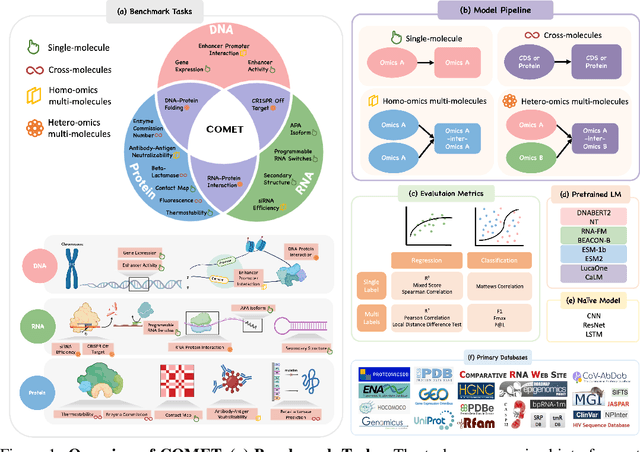
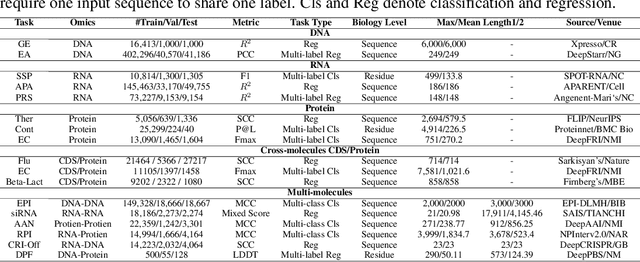

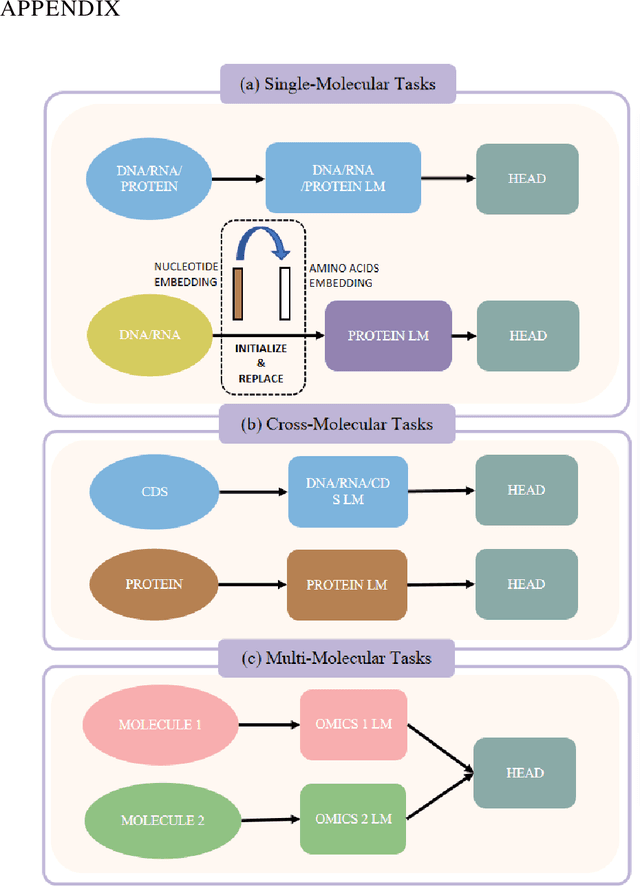
Abstract:As key elements within the central dogma, DNA, RNA, and proteins play crucial roles in maintaining life by guaranteeing accurate genetic expression and implementation. Although research on these molecules has profoundly impacted fields like medicine, agriculture, and industry, the diversity of machine learning approaches-from traditional statistical methods to deep learning models and large language models-poses challenges for researchers in choosing the most suitable models for specific tasks, especially for cross-omics and multi-omics tasks due to the lack of comprehensive benchmarks. To address this, we introduce the first comprehensive multi-omics benchmark COMET (Benchmark for Biological COmprehensive Multi-omics Evaluation Tasks and Language Models), designed to evaluate models across single-omics, cross-omics, and multi-omics tasks. First, we curate and develop a diverse collection of downstream tasks and datasets covering key structural and functional aspects in DNA, RNA, and proteins, including tasks that span multiple omics levels. Then, we evaluate existing foundational language models for DNA, RNA, and proteins, as well as the newly proposed multi-omics method, offering valuable insights into their performance in integrating and analyzing data from different biological modalities. This benchmark aims to define critical issues in multi-omics research and guide future directions, ultimately promoting advancements in understanding biological processes through integrated and different omics data analysis.
See or Guess: Counterfactually Regularized Image Captioning
Aug 29, 2024



Abstract:Image captioning, which generates natural language descriptions of the visual information in an image, is a crucial task in vision-language research. Previous models have typically addressed this task by aligning the generative capabilities of machines with human intelligence through statistical fitting of existing datasets. While effective for normal images, they may struggle to accurately describe those where certain parts of the image are obscured or edited, unlike humans who excel in such cases. These weaknesses they exhibit, including hallucinations and limited interpretability, often hinder performance in scenarios with shifted association patterns. In this paper, we present a generic image captioning framework that employs causal inference to make existing models more capable of interventional tasks, and counterfactually explainable. Our approach includes two variants leveraging either total effect or natural direct effect. Integrating them into the training process enables models to handle counterfactual scenarios, increasing their generalizability. Extensive experiments on various datasets show that our method effectively reduces hallucinations and improves the model's faithfulness to images, demonstrating high portability across both small-scale and large-scale image-to-text models. The code is available at https://github.com/Aman-4-Real/See-or-Guess.
BEACON: Benchmark for Comprehensive RNA Tasks and Language Models
Jun 14, 2024Abstract:RNA plays a pivotal role in translating genetic instructions into functional outcomes, underscoring its importance in biological processes and disease mechanisms. Despite the emergence of numerous deep learning approaches for RNA, particularly universal RNA language models, there remains a significant lack of standardized benchmarks to assess the effectiveness of these methods. In this study, we introduce the first comprehensive RNA benchmark BEACON (\textbf{BE}nchm\textbf{A}rk for \textbf{CO}mprehensive R\textbf{N}A Task and Language Models). First, BEACON comprises 13 distinct tasks derived from extensive previous work covering structural analysis, functional studies, and engineering applications, enabling a comprehensive assessment of the performance of methods on various RNA understanding tasks. Second, we examine a range of models, including traditional approaches like CNNs, as well as advanced RNA foundation models based on language models, offering valuable insights into the task-specific performances of these models. Third, we investigate the vital RNA language model components from the tokenizer and positional encoding aspects. Notably, our findings emphasize the superiority of single nucleotide tokenization and the effectiveness of Attention with Linear Biases (ALiBi) over traditional positional encoding methods. Based on these insights, a simple yet strong baseline called BEACON-B is proposed, which can achieve outstanding performance with limited data and computational resources. The datasets and source code of our benchmark are available at https://github.com/terry-r123/RNABenchmark.
Intruding with Words: Towards Understanding Graph Injection Attacks at the Text Level
May 26, 2024Abstract:Graph Neural Networks (GNNs) excel across various applications but remain vulnerable to adversarial attacks, particularly Graph Injection Attacks (GIAs), which inject malicious nodes into the original graph and pose realistic threats. Text-attributed graphs (TAGs), where nodes are associated with textual features, are crucial due to their prevalence in real-world applications and are commonly used to evaluate these vulnerabilities. However, existing research only focuses on embedding-level GIAs, which inject node embeddings rather than actual textual content, limiting their applicability and simplifying detection. In this paper, we pioneer the exploration of GIAs at the text level, presenting three novel attack designs that inject textual content into the graph. Through theoretical and empirical analysis, we demonstrate that text interpretability, a factor previously overlooked at the embedding level, plays a crucial role in attack strength. Among the designs we investigate, the Word-frequency-based Text-level GIA (WTGIA) is particularly notable for its balance between performance and interpretability. Despite the success of WTGIA, we discover that defenders can easily enhance their defenses with customized text embedding methods or large language model (LLM)--based predictors. These insights underscore the necessity for further research into the potential and practical significance of text-level GIAs.
Rethinking the BERT-like Pretraining for DNA Sequences
Oct 12, 2023Abstract:With the success of large-scale pretraining in NLP, there is an increasing trend of applying it to the domain of life sciences. In particular, pretraining methods based on DNA sequences have garnered growing attention due to their potential to capture generic information about genes. However, existing pretraining methods for DNA sequences largely rely on direct adoptions of BERT pretraining from NLP, lacking a comprehensive understanding and a specifically tailored approach. To address this research gap, we first conducted a series of exploratory experiments and gained several insightful observations: 1) In the fine-tuning phase of downstream tasks, when using K-mer overlapping tokenization instead of K-mer non-overlapping tokenization, both overlapping and non-overlapping pretraining weights show consistent performance improvement.2) During the pre-training process, using K-mer overlapping tokenization quickly produces clear K-mer embeddings and reduces the loss to a very low level, while using K-mer non-overlapping tokenization results in less distinct embeddings and continuously decreases the loss. 3) Using overlapping tokenization causes the self-attention in the intermediate layers of pre-trained models to tend to overly focus on certain tokens, reflecting that these layers are not adequately optimized. In summary, overlapping tokenization can benefit the fine-tuning of downstream tasks but leads to inadequate pretraining with fast convergence. To unleash the pretraining potential, we introduce a novel approach called RandomMask, which gradually increases the task difficulty of BERT-like pretraining by continuously expanding its mask boundary, forcing the model to learn more knowledge. RandomMask is simple but effective, achieving top-tier performance across 26 datasets of 28 datasets spanning 7 downstream tasks.
Improved Visual Story Generation with Adaptive Context Modeling
May 26, 2023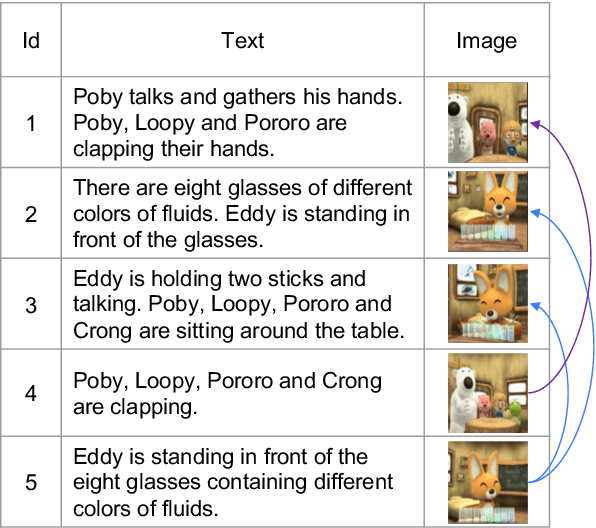

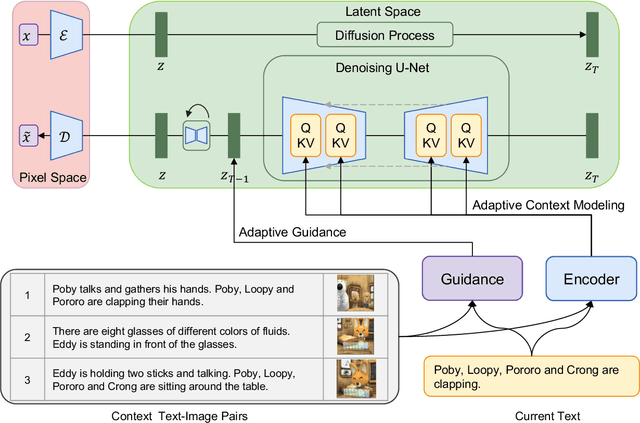
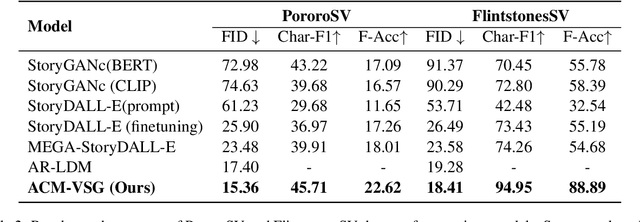
Abstract:Diffusion models developed on top of powerful text-to-image generation models like Stable Diffusion achieve remarkable success in visual story generation. However, the best-performing approach considers historically generated results as flattened memory cells, ignoring the fact that not all preceding images contribute equally to the generation of the characters and scenes at the current stage. To address this, we present a simple method that improves the leading system with adaptive context modeling, which is not only incorporated in the encoder but also adopted as additional guidance in the sampling stage to boost the global consistency of the generated story. We evaluate our model on PororoSV and FlintstonesSV datasets and show that our approach achieves state-of-the-art FID scores on both story visualization and continuation scenarios. We conduct detailed model analysis and show that our model excels at generating semantically consistent images for stories.
 Add to Chrome
Add to Chrome Add to Firefox
Add to Firefox Add to Edge
Add to Edge